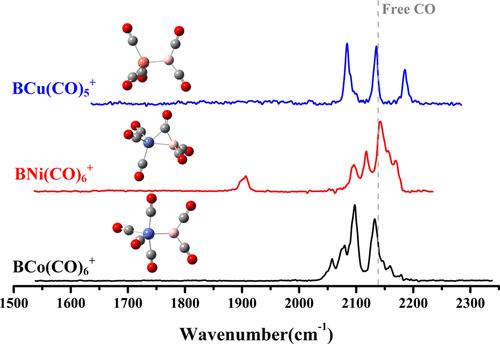当前位置:
X-MOL 学术
›
J. Phys. Chem. A
›
论文详情
Our official English website, www.x-mol.net, welcomes your feedback! (Note: you will need to create a separate account there.)
Infrared Photodissociation Spectroscopy of Mass-Selected Dinuclear Transition Metal Boride Carbonyl Cluster Cations
The Journal of Physical Chemistry A ( IF 2.9 ) Pub Date : 2024-03-12 , DOI: 10.1021/acs.jpca.3c07819 Jin Hu 1 , Ke Xin 1 , Xuan Lin 1 , Xiaopeng Xing 1 , Xuefeng Wang 1
The Journal of Physical Chemistry A ( IF 2.9 ) Pub Date : 2024-03-12 , DOI: 10.1021/acs.jpca.3c07819 Jin Hu 1 , Ke Xin 1 , Xuan Lin 1 , Xiaopeng Xing 1 , Xuefeng Wang 1
Affiliation

|
The transition-metal–boron bonding interactions and geometric structures of heterodinuclear transition metal carbonyl cluster cations BM(CO)n+ (M = Co, Ni, and Cu) are studied by a combination of the infrared photodissociation spectroscopy and density functional theory calculations at the B3LYP/def2-TZVP level. The BCu(CO)5+ and BCo(CO)6+ cations are characterized as an (CO)2B–M(CO)3/4+ structure involving an σ-type (OC)2B → M(CO)3,4+ dative bonding with end-on carbonyls, while for BNi(CO)5,6+ complexes with a bridged carbonyl, a 3c–2e bond involving the 5σ electrons of the bridged carbonyl and an electron-sharing bond between the B(CO)2 fragment and the Ni(CO)2,3+ subunits were revealed. Moreover, the fundamental driving force of the exclusive existence of a bridged carbonyl group in the boron–nickel complexes has been demonstrated to stem from the desire of the B and Ni centers for the favorable 8- and 18-electron structures.
中文翻译:

质量选择双核过渡金属硼化物羰基簇阳离子的红外光解光谱
通过红外光解离光谱和密度泛函理论计算的结合,研究了异双核过渡金属羰基簇阳离子 BM(CO) n + (M = Co、Ni 和 Cu) 的过渡金属-硼键相互作用和几何结构。 B3LYP/def2-TZVP 水平。 BCu(CO) 5 +和 BCo(CO) 6 +阳离子的特征为 (CO) 2 B–M(CO) 3/4 +结构,涉及 σ 型 (OC) 2 B → M(CO) 3 ,4 +与末端羰基形成配位键,而对于具有桥接羰基的 BNi(CO) 5,6 +配合物,涉及桥接羰基的 5σ 电子的 3c–2e 键和 B( CO) 2片段和 Ni(CO) 2,3 +亚基被揭示。此外,硼镍配合物中桥连羰基的唯一存在的基本驱动力已被证明源于B和Ni中心对有利的8和18电子结构的需求。
更新日期:2024-03-12
中文翻译:

质量选择双核过渡金属硼化物羰基簇阳离子的红外光解光谱
通过红外光解离光谱和密度泛函理论计算的结合,研究了异双核过渡金属羰基簇阳离子 BM(CO) n + (M = Co、Ni 和 Cu) 的过渡金属-硼键相互作用和几何结构。 B3LYP/def2-TZVP 水平。 BCu(CO) 5 +和 BCo(CO) 6 +阳离子的特征为 (CO) 2 B–M(CO) 3/4 +结构,涉及 σ 型 (OC) 2 B → M(CO) 3 ,4 +与末端羰基形成配位键,而对于具有桥接羰基的 BNi(CO) 5,6 +配合物,涉及桥接羰基的 5σ 电子的 3c–2e 键和 B( CO) 2片段和 Ni(CO) 2,3 +亚基被揭示。此外,硼镍配合物中桥连羰基的唯一存在的基本驱动力已被证明源于B和Ni中心对有利的8和18电子结构的需求。



























 京公网安备 11010802027423号
京公网安备 11010802027423号